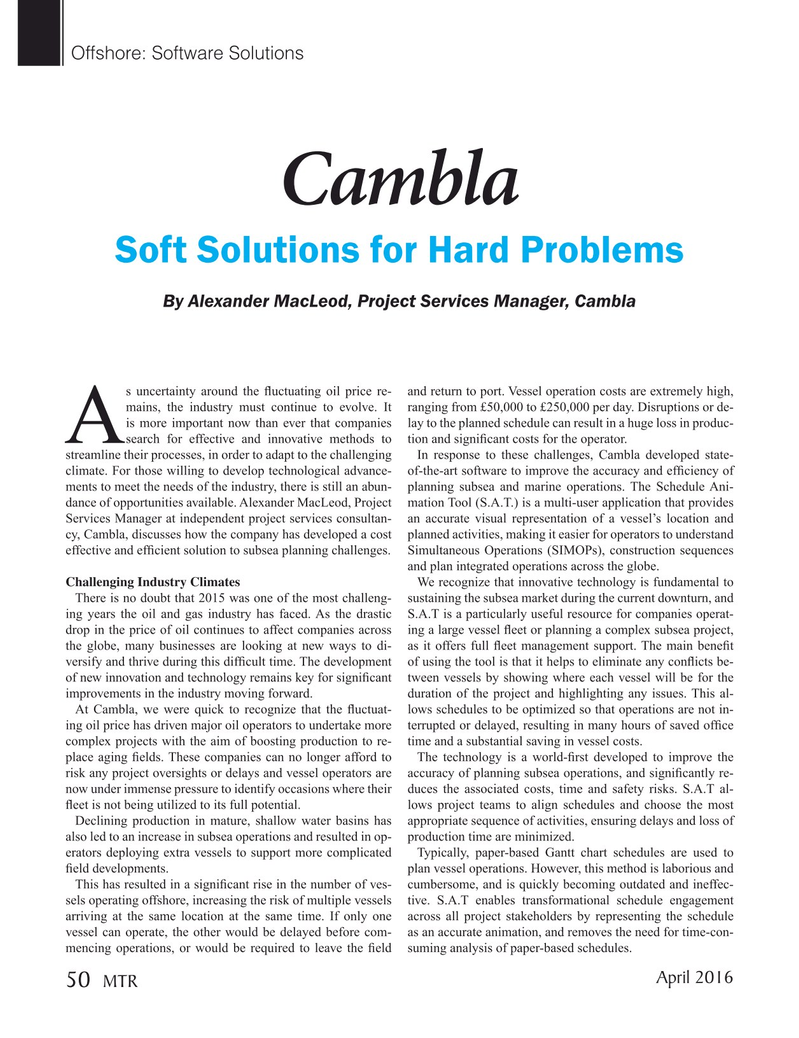
Page 50: of Marine Technology Magazine (April 2016)
Offshore Energy Annual
Read this page in Pdf, Flash or Html5 edition of April 2016 Marine Technology Magazine
Offshore: Software Solutions
Cambla
Soft Solutions for Hard Problems
By Alexander MacLeod, Project Services Manager, Cambla s uncertainty around the ? uctuating oil price re- and return to port. Vessel operation costs are extremely high, mains, the industry must continue to evolve. It ranging from £50,000 to £250,000 per day. Disruptions or de- is more important now than ever that companies lay to the planned schedule can result in a huge loss in produc-
A search for effective and innovative methods to tion and signi? cant costs for the operator. streamline their processes, in order to adapt to the challenging In response to these challenges, Cambla developed state- climate. For those willing to develop technological advance- of-the-art software to improve the accuracy and ef? ciency of ments to meet the needs of the industry, there is still an abun- planning subsea and marine operations. The Schedule Ani- dance of opportunities available. Alexander MacLeod, Project mation Tool (S.A.T.) is a multi-user application that provides
Services Manager at independent project services consultan- an accurate visual representation of a vessel’s location and cy, Cambla, discusses how the company has developed a cost planned activities, making it easier for operators to understand effective and ef? cient solution to subsea planning challenges. Simultaneous Operations (SIMOPs), construction sequences and plan integrated operations across the globe.
Challenging Industry Climates We recognize that innovative technology is fundamental to
There is no doubt that 2015 was one of the most challeng- sustaining the subsea market during the current downturn, and ing years the oil and gas industry has faced. As the drastic S.A.T is a particularly useful resource for companies operat- drop in the price of oil continues to affect companies across ing a large vessel ? eet or planning a complex subsea project, the globe, many businesses are looking at new ways to di- as it offers full ? eet management support. The main bene? t versify and thrive during this dif? cult time. The development of using the tool is that it helps to eliminate any con? icts be- of new innovation and technology remains key for signi? cant tween vessels by showing where each vessel will be for the improvements in the industry moving forward. duration of the project and highlighting any issues. This al-
At Cambla, we were quick to recognize that the ? uctuat- lows schedules to be optimized so that operations are not in- ing oil price has driven major oil operators to undertake more terrupted or delayed, resulting in many hours of saved of? ce complex projects with the aim of boosting production to re- time and a substantial saving in vessel costs.
place aging ? elds. These companies can no longer afford to The technology is a world-? rst developed to improve the risk any project oversights or delays and vessel operators are accuracy of planning subsea operations, and signi? cantly re- now under immense pressure to identify occasions where their duces the associated costs, time and safety risks. S.A.T al- ? eet is not being utilized to its full potential. lows project teams to align schedules and choose the most
Declining production in mature, shallow water basins has appropriate sequence of activities, ensuring delays and loss of also led to an increase in subsea operations and resulted in op- production time are minimized. erators deploying extra vessels to support more complicated Typically, paper-based Gantt chart schedules are used to ? eld developments. plan vessel operations. However, this method is laborious and
This has resulted in a signi? cant rise in the number of ves- cumbersome, and is quickly becoming outdated and ineffec- sels operating offshore, increasing the risk of multiple vessels tive. S.A.T enables transformational schedule engagement arriving at the same location at the same time. If only one across all project stakeholders by representing the schedule vessel can operate, the other would be delayed before com- as an accurate animation, and removes the need for time-con- mencing operations, or would be required to leave the ? eld suming analysis of paper-based schedules.
April 2016
MTR 50
MTR #3 (50-64).indd 50 4/4/2016 10:03:45 AM

 49
49

 51
51
